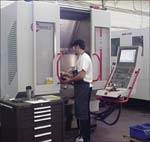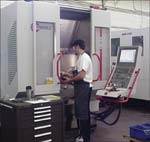Century Die: Forging Ahead
Manufacturing blow molds has kept this moldmaker in the black for more than fifty years-and has earned them an Honorable Mention in MoldMaking Technology magazine's Leadtime Leader competition.
Specialization has been the name of Fremont, OH-based Century Die Company's game since 1946, when the company was founded as a forging die manufacturer. Now, this producer of wheel and shuttle extrusion blow molds, stretch blow molds and support tooling saw $8 million in sales in 2003-along with 18 percent annual sales growth throughout the past three years.
With an average leadtime of a week and a half on prototype molds and three weeks on production mold units, the company-comprised of more than ninety employees-combines aggressive manufacturing techniques, the latest in equipment and lean manufacturing principles to get the job done quickly and efficiently.
History Lesson
Back in 1946, Lauren A. Maloy established Century Die to provide forging dies to brass faucet suppliers. In the early 1950s, Maloy saw potential in the emerging plastics industry and in 1960 decided to manufacture molds for that industry. Its first blow molds were delivered in 1961 to Dial Purex, which used them to make plastic bottles for laundry detergent. In the 1970s, the shop continued to grow to just under twenty employees, and by the 1980s, another ten people were added-taking the shop size to approximately thirty employees. By the early 1990s, a surge in the industry pushed Century Die to its largest growth and market share-with a 100 percent increase in capacity and employee growth.
In 1995, Century Die expanded its building in Fremont, OH by 80 percent as part of a five-year strategy to meet growing production demands-doubling its total floor capacity. The company immediately began installing some of the latest machining equipment and continues to invest in cutting-edge, numerically controlled moldmaking equipment (see Equipment sidebar). In November 2000, the company acquired Luther Lane Tool Corporation in Anaheim, CA-further strengthening its place in the blow mold industry.
Today, Century Die has evolved into a manufacturer of molds for several of the top ten bottle makers in the world, according to general manager Paul Betz. "Our molds are also used in the automotive industry, lawn and garden, and for making toys and packaging," he states.
Art to Part
Betz reports that the company likes to think of itself as more of a rapid product provider rather than simply a mold provider. "As an example, we can take a customer's 2-D sketch on Monday to a blown part by Friday," he notes. "We give the 2-D sketch to our model maker. Then, he makes the model on day one; by day two, the model is scanned and the toolpath is created to cut. On day three, the cavity is cut and day five, we blow the bottles in our test blow facility."
These tight leadtimes are maintained by aggressive manufacturing techniques coupled with cutting edge technology, Betz says. Along with lean manufacturing, the company practices what Betz calls continuous improvement-the need to constantly improve its business methods and work smarter, not harder. Once lean manufacturing and continuous improvement methods were introduced to its employees, the company implemented a number of changes throughout the shop.
"We use the Made 2 Manage [ERP System], our stock is maintained in-house, we employ fixturizing and palletizing to reduce setup time and maintain accuracy, and we established standardization in engineering and unattended machining," he explains. "We have cut our finishing time considerably by implementing these lean-to-mean manufacturing principles, like the push-and-pull theory, which involves reorganizing the shop floor so all equipment and tools are closer to the operators. Additionally, we EDM to burn detail areas of cavities, which reduces bench time and in turn reduces leadtime. We perform more operations in one setup to reduce setup time. We also have employees running multiple machines at once."
Century Die also offers full service onsite with troubleshooting of mold and trim tooling problems. "With the addition of our west coast facility-coupled with our east coast facility-we are able to better service our customers from coast to coast," Betz states.
Furthermore, the company guarantees quick and timely delivery with quality mold-to-mold consistency. "Our mold components are interchangeable with any other mold within the set," he explains. "The critical dimensions of the neck finish and cavity are consistent with all other molds. With the close tolerances, it is possible to interchange components from one mold to another and match. Plus, with our laser scanning capabilities we can take point cloud data to surfaces in a matter of hours. We also have one of the top welders in the country-he has forty years of experience-to do intricate pinch repairs in-house. This is an area where the skill of a craftsman is developed over years of practice."
Investing in the Future
Century Die is actively involved in training the future moldmakers of America. "We have a tool and die apprenticeship program set up with the local college, Terra Community College," Betz says. "We helped set them up with Unigraphics so we could train our new employees-and at the same time-have the college start a new UG class. This way, we can have qualified candidates to employ and maintain a viable apprenticeship program. It takes a long time to train, search for and find the right people to work in the mold and die trade. Once found and/or trained, keeping employees with the constant challenge of health care costs and rising wages is difficult." Century rises to this challenge with a "complete package"-including wage, bonus, 401(k), insurance, excellent working conditions and a stable customer base, Betz points out.
The company also works with the Society of Mechanical Engineers (SME), Society of Plastic Engineers (SPE), National Tooling & Machining Association (NTMA) and the American Mold Builders Association (AMBA)-attending seminars to keep up with cutting-edge technology.
According to Betz, one of the company's most rigorous challenges is foreign competition-especially Canada. "With surging imports from Canada passing the $158.7 billion dollar mark, it is obviously our biggest threat," he states. "We have attempted to overcome some or part of this problem with our ability to shrink our leadtimes."
The company also plans to become more actively involved in dealing with this issue. "We'd like to bring further attention to the issue in Washington," he notes. "Canada does more importing to the U.S. than China, Japan and Mexico. Manufacturing operations in the USA continues to be adjusted to compensate; many plants have been forced to close because of these surging imports. Perhaps a lot of voices can get some kind of bill passed that will at least limit or level the playing field." To that end, Century Die is on the National Business Advisory Council for the State of Ohio, with Betz serving as an "honorary chairman" with plans to participate in the "negotiated regulations to reach and strive for this fair and level playing field."
This upcoming year also will see the company continue to reduce manufacturing and engineering leadtime so it can lower costs to compete with foreign companies and provide a higher quality product with quicker deliveries, Betz promises. "We have outgrown our new addition and are planning to add onto our building to accommodate new machine purchases and are in the process of purchasing surrounding property for future expansion."
| The Five-Year Plan |
According to Paul Betz, planning consecutive successful years involves a complete and functional business plan. Therefore, Century outlines its next five years in the following plan, which also includes an operating budget, investment budget and cash flow.
|
Related Content
Making Quick and Easy Kaizen Work for Your Shop
Within each person is unlimited creative potential to improve shop operations.
Read MoreTackling a Mold Designer Shortage
Survey findings reveal a shortage of skilled mold designers and engineers in the moldmaking community, calling for intervention through educational programs and exploration of training alternatives while seeking input from those who have addressed the issue successfully.
Read MoreHow to Improve Your Current Efficiency Rate
An alternative approach to taking on more EDM-intensive work when technology and personnel investment is not an option.
Read MoreConfronting the Mold Design Talent Drought
Recently, I reposted on LinkedIn the results of an informal survey we conducted, which revealed a shortage of skilled mold designers. It quickly gained a lot of traction. Given the response, I thought I'd summarize the feedback and keep the conversation going.
Read MoreRead Next
Ryka Molds: Project Mgmt and Performance Flow Get Results
This moldmaker bottles up a successful formula of an engineering-driven approach coupled with value-added services with a niche focus on blow molds.
Read MoreReasons to Use Fiber Lasers for Mold Cleaning
Fiber lasers offer a simplicity, speed, control and portability, minimizing mold cleaning risks.
Read MoreHow to Use Continuing Education to Remain Competitive in Moldmaking
Continued training helps moldmakers make tooling decisions and properly use the latest cutting tool to efficiently machine high-quality molds.
Read More





















